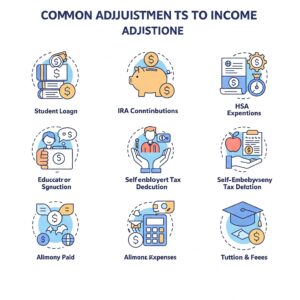What is adjusted gross income?
Adjusted Gross Income (AGI) is your gross income (everything you earned during the year from wages, investments, business income, etc.) minus specific deductions, also called “adjustments to income.” AGI is a key figure on your tax return and determines your eligibility for various credits, deductions, and tax rates.

🔍 In Simple Terms:
AGI = Total Income – IRS-Approved Deductions
💵 What Counts as Income?
-
Wages and salaries (from your W-2)
-
Self-employment income
-
Rental income
-
Unemployment compensation
-
Interest and dividends
-
Capital gains

✂️ Common Adjustments (Deductions) to Income:
-
Student loan interest
-
IRA contributions
-
HSA (Health Savings Account) contributions
-
Educator expenses
-
Alimony paid (for divorces finalized before 2019)
-
Self-employment tax deduction
-
Tuition and fees (if eligible)
📍 Where to Find AGI:
-
Form 1040, Line 11 on the 2023 return
📌 Why It Matters:
-
Your AGI affects your standard deduction eligibility, taxable income, and credits like the Child Tax Credit, Earned Income Credit, and education credits.
What is Adjusted Gross Income (AGI)?
When navigating the world of taxes, Adjusted Gross Income (AGI) plays a central role. It’s one of the key figures that determine how much tax you owe and whether you’re eligible for various deductions and credits. In simple terms, AGI is your total income minus specific deductions. It’s a crucial concept for anyone filing taxes, especially if you’re hoping to reduce your taxable income or maximize potential tax refunds.
In this comprehensive guide, we’ll explore what AGI is, how it’s calculated, and why it matters. By the end of this article, you’ll understand why AGI is essential for tax planning and how it can impact your financial situation.
Agi taxes – what is agi taxes?
When people refer to “AGI taxes,” they usually mean how your Adjusted Gross Income (AGI) impacts the amount of income tax you owe. AGI itself is not a tax, but it plays a crucial role in calculating your taxable income and determining your overall tax liability.
What is your agi? What is the agi on taxes
AGI (Adjusted Gross Income) on taxes is your total income minus specific IRS-approved deductions. It’s a key number used to determine your taxable income, eligibility for credits, and deductions.
🧾 AGI = Income – Adjustments (like student loan interest, IRA contributions, etc.)
You can find it on Form 1040, Line 11 of your tax return.
📊 How AGI Affects Your Taxes
1. Taxable Income Calculation
Your taxable income is what the IRS uses to figure out how much tax you owe. It’s based on your AGI.
Formula:
2. Eligibility for Tax Credits and Deductions
Many tax credits and deductions phase out or disappear as your AGI increases. For example:
-
Child Tax Credit
-
Earned Income Credit
-
Education Credits (like American Opportunity Credit)
-
Saver’s Credit
-
Premium Tax Credit (health insurance subsidies)
3. Income Thresholds for Tax Brackets
Your AGI helps determine where you fall in the federal income tax brackets, which range from 10% to 37%.
💡 Example
Let’s say you:
-
Earned $80,000 total income
-
Deducted $2,000 in student loan interest
-
Your AGI = $78,000
-
Subtract the standard deduction (say $13,850 for single filers in 2023)
Your taxable income is $64,150 — which is what the IRS uses to determine your tax bill.
📍 Bottom Line:
-
AGI is a starting point for figuring out your taxes.
-
Lowering your AGI (through deductions) can mean paying less in taxes and qualifying for more credits.
What is your adjusted gross income
Your Adjusted Gross Income (AGI) is your total income for the year minus certain specific deductions (also known as adjustments). It’s essentially your income after “above-the-line” deductions but before standard or itemized deductions.
🔹 So, to answer:
What is your adjusted gross income?
It depends on your personal income and any eligible deductions, but here’s how you figure it out:
✅ Step-by-Step: How to Calculate AGI
-
Add up your total income, including:
-
Wages (W-2)
-
Self-employment income (1099)
-
Interest and dividends
-
Rental income
-
Capital gains
-
Unemployment compensation
-
Retirement distributions (some)
-
-
Subtract IRS-allowed deductions:
-
Student loan interest
-
Traditional IRA contributions
-
Health Savings Account (HSA) contributions
-
Educator expenses
-
Alimony (pre-2019 agreements)
-
Half of your self-employment tax
-
Tuition and fees (if eligible)
-
🧮 Example:
-
Total income = $70,000
-
Deductions = $3,000 (student loan interest + HSA contribution)
-
AGI = $67,000
📝 Where to Find AGI:
-
If you filed taxes last year, look on Form 1040, Line 11.
The Basics of Adjusted Gross Income
Adjusted Gross Income (AGI) refers to the amount of your income that’s left after you’ve subtracted allowable deductions (often called “adjustments”) from your total gross income. This figure is used to determine your taxable income, which in turn dictates your tax obligations.
For example, if you earn $50,000 a year and are eligible for $5,000 in deductions, your AGI would be $45,000.
How is AGI Calculated?
The process to calculate your AGI is straightforward but can involve several steps. Here’s how you do it:
- Start with your gross income – This includes wages, dividends, retirement distributions, and rental income.
- Subtract allowable deductions – These can include student loan interest, contributions to retirement accounts, and health savings accounts.
The result is your Adjusted Gross Income.
Why Does AGI Matter for Your Taxes?
Your AGI is more than just a number on your tax return. It has several significant impacts on your taxes, including:
- Eligibility for Deductions and Credits
Many tax deductions and credits are determined based on your AGI. For example, to qualify for the Earned Income Tax Credit (EITC), your AGI must fall below a certain threshold. Similarly, certain deductions, like those for medical expenses, are only available if your AGI is low enough. - Tax Bracket Determination
AGI helps determine which tax bracket you fall into. The lower your AGI, the less you will pay in taxes. - Tax Filing
When you file your tax return, your AGI is one of the first numbers you’ll need to calculate. It affects both the total amount of taxes owed and your eligibility for other tax benefits.
Related Keywords and Concepts to Understand AGI
When researching Adjusted Gross Income, you may come across several related concepts. Here are some of the most important ones:
- AGI vs Gross Income: Gross income is the total amount you earn before any deductions, while AGI accounts for deductions, giving you a clearer picture of your taxable income.
- AGI Tax Deductions: These are the specific deductions you can subtract from your total income to lower your AGI. Common deductions include retirement contributions and student loan interest.
- Tax Benefits AGI: A lower AGI can help you qualify for more tax benefits, including tax credits and deductions that reduce your overall tax burden.
- Impact of AGI on Taxes: Your AGI influences how much you pay in taxes, as it determines your eligibility for deductions, credits, and tax brackets.
Gross income vs adjusted gross income
Here’s a clear and concise comparison in resume-style format to help you quickly understand the difference between Gross Income and Adjusted Gross Income (AGI):
📄 Gross Income vs. Adjusted Gross Income (AGI) – Quick Resume
| Category | Gross Income | Adjusted Gross Income (AGI) |
|---|---|---|
| Definition | Total income earned before any deductions | Gross income minus IRS-approved deductions |
| Includes | Wages, salaries, tips, bonuses, dividends, rental income, business income, etc. | Everything in gross income, before subtracting adjustments |
| Deductions Applied? | ❌ No deductions applied | ✅ Yes – student loan interest, HSA contributions, etc. |
| Used For | Starting point for tax calculation | Determines taxable income and eligibility for credits |
| Found On Tax Forms | Not always shown directly, but part of tax worksheet | Form 1040, Line 11 |
| Example Amount | $80,000 (total income) | $75,000 (after $5,000 in deductions) |
| Affects | Just the base number | Credits, deductions, tax brackets, and refund size |
How to Reduce Your AGI
Reducing your AGI is a smart strategy for lowering your taxable income and potentially paying less in taxes. Here are some methods to consider:
- Contribute to Retirement Accounts
Contributions to retirement accounts like a 401(k) or IRA can reduce your AGI. For example, putting money into a traditional IRA can lower your taxable income for the year. - Take Advantage of Tax Deductions
Deductible expenses, such as student loan interest, HSA contributions, and tuition fees, can reduce your AGI. Always consult a tax advisor to ensure you’re claiming all available deductions. - Use Health Savings Accounts (HSAs)
Contributions to an HSA are tax-deductible, which can lower your AGI and your overall tax liability.
AGI and Tax Credits
Your AGI also impacts the amount and eligibility for tax credits. Here are a few credits affected by AGI:
- Earned Income Tax Credit (EITC): This credit is aimed at helping low-to-moderate-income earners. Your AGI must fall within certain limits to qualify.
- Child Tax Credit: Your AGI must be below a certain threshold to receive the full Child Tax Credit.
- American Opportunity Tax Credit (AOTC): This credit, which helps with college expenses, phases out as your AGI increases.

Understanding AGI Deductions for 2025
As tax laws change, it’s important to stay up-to-date on how your AGI deductions will evolve. For 2025, certain deductions may become more generous, while others may change. Some of the key changes to watch out for include:
- Increased limits for contributions to retirement accounts.
- Potential changes in tax benefits for student loan interest deductions.
- Modified AGI thresholds for tax credits.
FAQs About Adjusted Gross Income (AGI)
1. What is the difference between AGI and gross income?
Gross income is your total income before deductions, while AGI is the amount after deductions have been applied. AGI gives a better idea of what’s actually taxable.
2. How do I calculate my AGI?
Start with your total income and subtract allowable deductions, such as retirement contributions and student loan interest. The result is your AGI.
3. Why is AGI important for tax planning?
Your AGI determines your eligibility for tax deductions, credits, and the tax bracket you’ll fall into. It’s a crucial factor in minimizing your overall tax liability.
4. Can I reduce my AGI?
Yes, you can reduce your AGI by contributing to retirement accounts, using HSAs, or claiming deductions like student loan interest or tuition fees.
5. How does AGI affect my tax return?
Your AGI impacts your overall tax return by determining which tax benefits you qualify for, including deductions and credits, and helps set your tax bracket.
Conclusion: Why Understanding AGI is Crucial for Your Financial Planning
Understanding Adjusted Gross Income is an essential part of effective financial and tax planning. By knowing how to calculate and reduce your AGI, you can take control of your finances, maximize your tax benefits, and minimize your tax liability. With the right strategies, you can improve your financial health and achieve your long-term goals.
Stay informed and make the most of your AGI to ensure you’re not leaving money on the table when filing your taxes.







